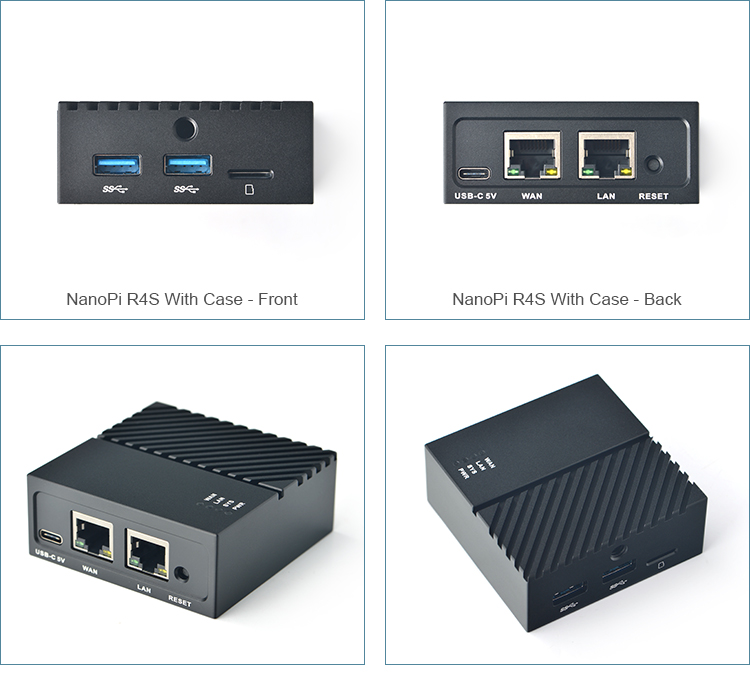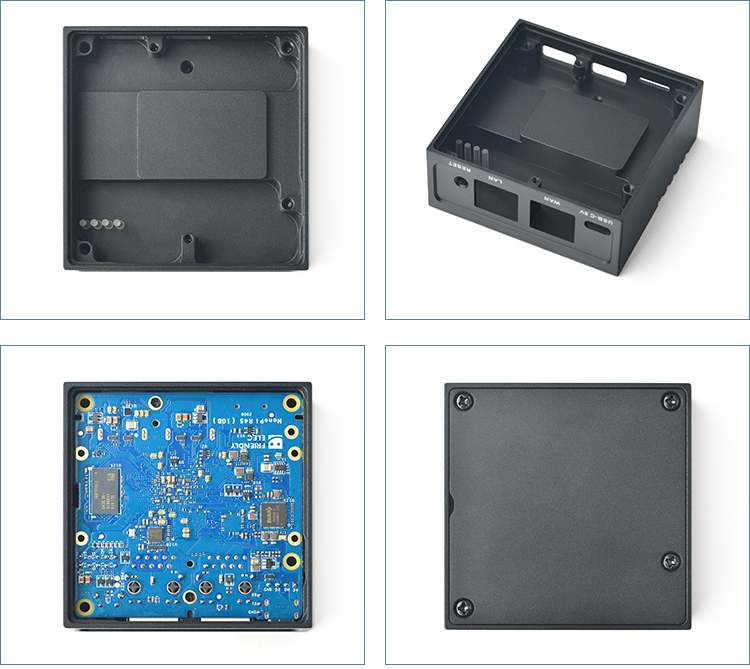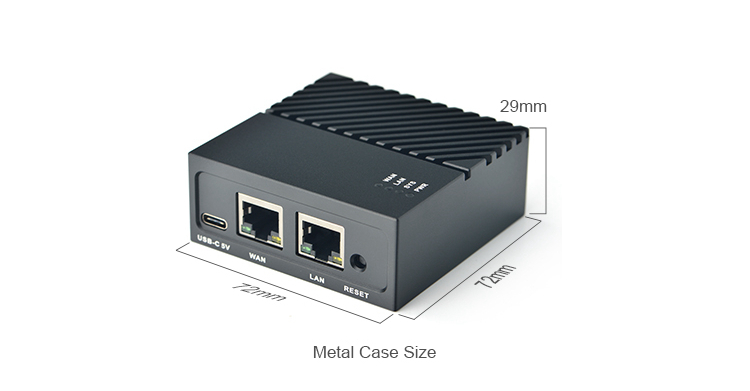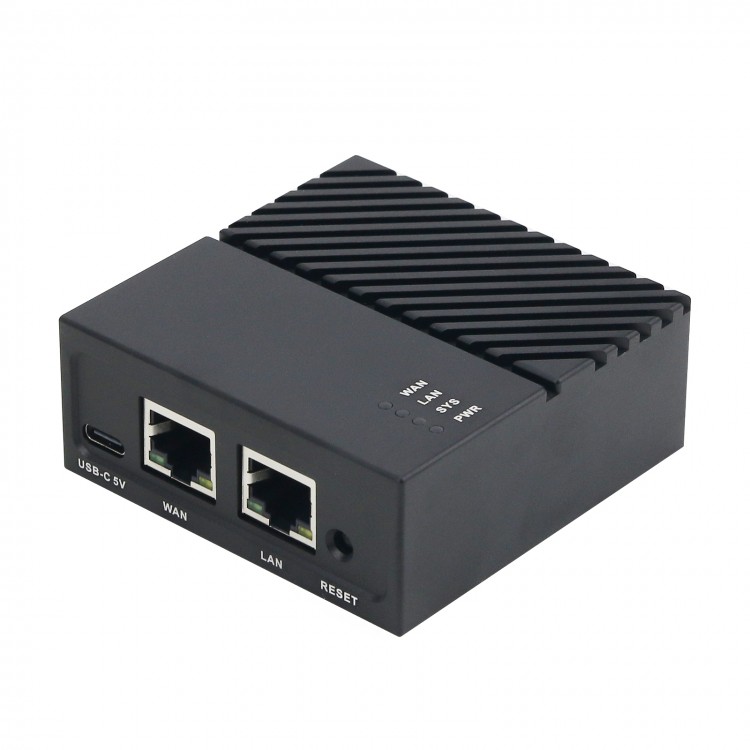
| Quantity | 3+ units | 10+ units | 30+ units | 50+ units | More |
|---|---|---|---|---|---|
| Price /Unit | $115.25 | $112.90 | $109.37 | $104.66 | Contact US |
 Bjorn Automated Autonomous Network Scanning Vulnerability Assessment E-Ink Network Security Tool
$93.60
Bjorn Automated Autonomous Network Scanning Vulnerability Assessment E-Ink Network Security Tool
$93.60
 V1600GS-F (VSOL-V1600GS-F) 1-Port GPON OLT Boasts 1 GPON 2 RJ45 1 SFP/SFP+ and Cooling Fan
$319.19
V1600GS-F (VSOL-V1600GS-F) 1-Port GPON OLT Boasts 1 GPON 2 RJ45 1 SFP/SFP+ and Cooling Fan
$319.19
 TF200 NTP Time Server NTP Network Time Server Time with 10m Antenna for Beidou GPS GLONASS and QZSS
$170.25
TF200 NTP Time Server NTP Network Time Server Time with 10m Antenna for Beidou GPS GLONASS and QZSS
$170.25
NanoPi R4S Mini Router 4GB Memory Metal Shell RK3399 Two Gigabit Ethernet Port Networking Parts
Attention:
Before
using your NanoPi R4S, please get the following items ready. 5V 2A
charging head (quick charge forbidden), USB-C cable, C10-TF card
(firmware and card making tutorial will be mentioned later).
NanoPi R4S router system card production steps:
1. Download system firmware: http://www.arm9home.net/read.php?tid-289059.html
2.
Flash to TF card: Unzip the downloaded system firmware and the flashing
tool win32diskimager.rar separately, insert a TF card for Windows (only
4G and above Class10 cards), right-click to run the flashing tool
win32diskimager as an administrator. And on the interface of the
flashing tool win32diskimager, select your TF card drive letter (you
must choose the right drive letter, otherwise there is a risk of
formatting other mobile hard drives), select the system firmware you
want to burn, and click the Write button to burn.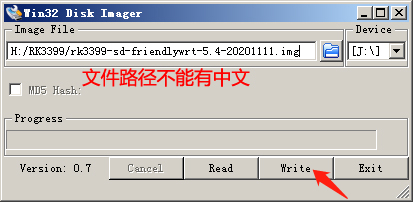
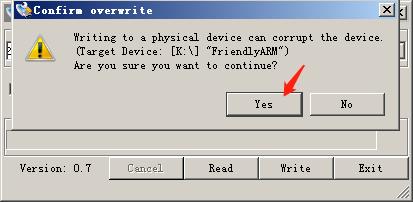
After successful programming, you will see the following interface:
After
making the TF card, pull out the TF card and insert it into BOOT card
slot, power on and start. It is recommended to use a traditional 5V3A or
5V4A power adapter (Note: Some QC/PD fast chargers may have
compatibility issues), you can see PWR red light is always on and the
SYS green light is flashing. At this time, you have successfully started
the system.
3 Ways to Log in the Router:
1: If you
have purchased 5G-WIFI, you can log in using WIFI connection: search for
the hotspot starting with FriendlyWrt in your computer, the password is
password, and input 192.168.2.1 in the browser (recommended browser for
Google);
2: Use LAN port connection to log in: Connect the WAN port
of NanoPi R4S to the LAN port of your upper-level router, set the
computer network card to "get an IP address automatically", use a
network cable to connect the computer network port to the LAN port of
NanoPi R4S, input http://friendlywrt/ or 192.168.2.1 in the browser
(recommended browser for Google);
3: Use WAN port connection to log
in: check the IP address of NanoPi R4S router, first connect the WAN
port of the NanoPi R4S to the LAN port of your upper-level router, then
log in to your upper-level router, check the client list, and find the
host name that corresponds to IP address for FriendlyWrt, as shown below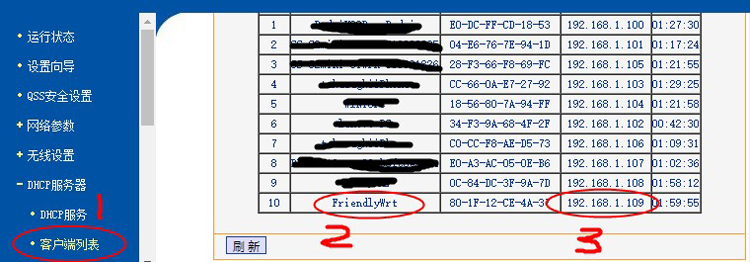
Input this IP address in the browser and press Enter and enter the user name (root) and password (password) to log in.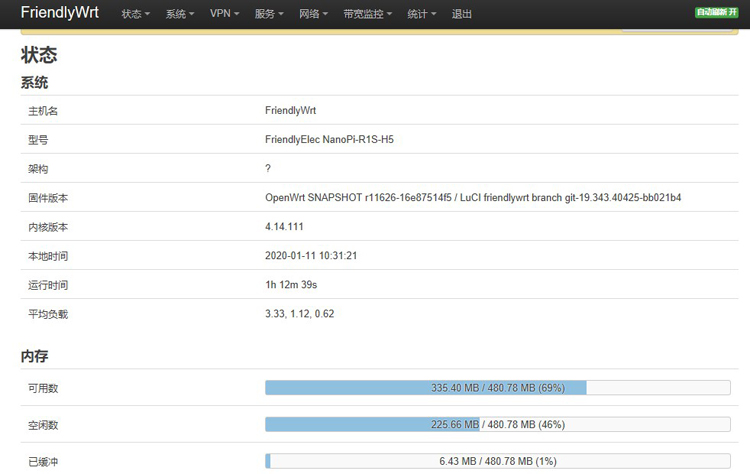
Download Materials:
1. WiKi tutorial (firmware introduction, instructions for use, operation steps, etc.) http://wiki.friendlyarm.com/wiki/index.php/NanoPi_R4S
2. Download other system firmware: http://download.friendlyarm.com/nanopir4s
3. Schematic (pdf format):
https://wiki.friendlyarm.com/wiki/images/0/06/NanoPi-R4S-1GB-2008-Schematic.pdf
https://wiki.friendlyarm.com/wiki/images/c/c2/NanoPi-R4S-4GB-2008-Schematic.pdf
4. Dimensions (dxf format):
https://wiki.friendlyarm.com/wiki/images/a/ab/NanoPi_R4S_1GB_2008_dxf.zip
https://wiki.friendlyarm.com/wiki/images/1/18/NanoPi_R4S_4GB_2008_dxf.zip
Introduction:
NanoPi
R4S is a high-end dual gigabit edge computing mini router with a
motherboard size of only 66x66mm. It uses USB-C interface for power
supply, and can support running open-source systems for Friendly WRT,
Ubuntu, Armbian, etc.
NanoPi R4S uses a high-performance
hexa-core processor RK3399 as the main control. The default maximum
operating frequency is 1.8GHz, and it comes with 1GB DDR3 or 4GB LPDDR4
memory. It has two dual Gigabit Ethernet interfaces and supports dynamic
configuration and voltage regulation. It also has a 2-way USB 3.0
interface, which can be used with external mobile hard drives, or expand
4G modules, USB high-definition cameras, USB WiFi and other modules.
In
addition, users can choose a CNC all-metal shell, which is not only
well-made, but also has a good heat dissipation effect, which can ensure
that the system runs without frequency reduction in the whole process.
Advantages:
- For Rockchip RK3399
- For Dual-core Cortex-A72 & Quad-core Cortex A53
- 1GB DDR3 or 4GB LPDDR4 RAM
-
Dual Gbps Ethernet ports: NanoPi R4S has two Gigabit Ethernet, one is
directly derived from SoC, and the other is connected by PCIe. The
transmission rate of the Gigabit Ethernet port directly derived from
NanoPi R4S is 934Mbps and the reception rate is 936Mbps; the
transmission rate of the Gigabit Ethernet port that PCIe transfers is
934Mbps, and the reception rate is 941Mbps
- USB 3.0 x 2
- Unique Address for MAC
- Multi OS
- GPIO & USB Pin Header
- USB-C Power Supply
- TF Card Bootable System
Package Included:
- 1 x Set of NanoPi R4S
Note:
- Card reader is not included.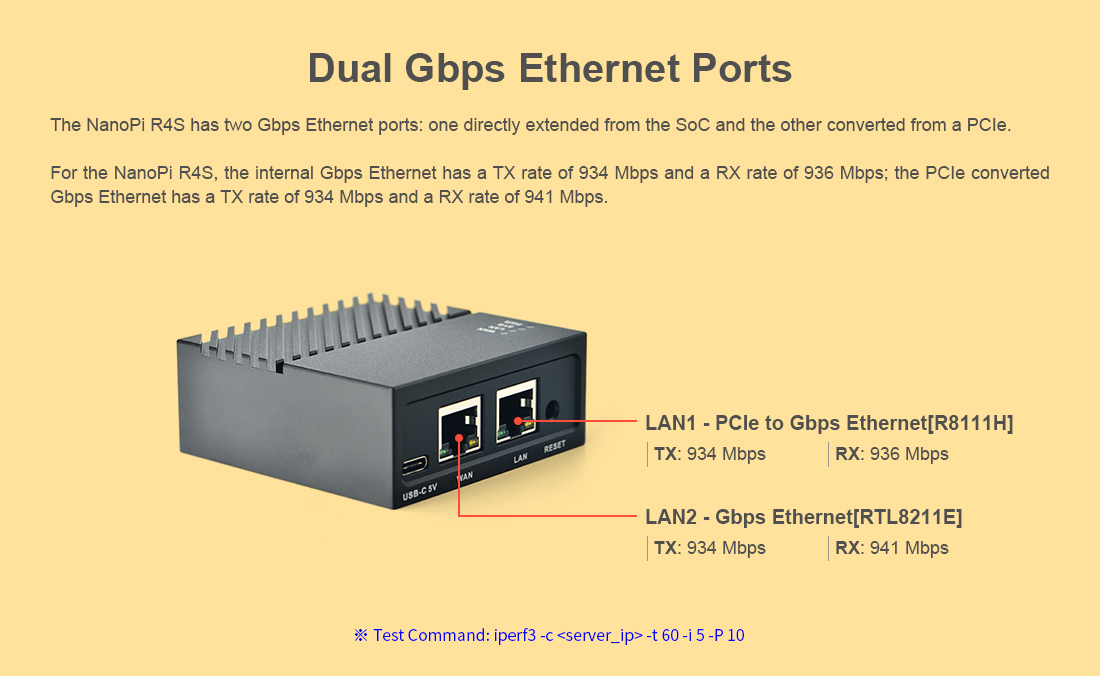
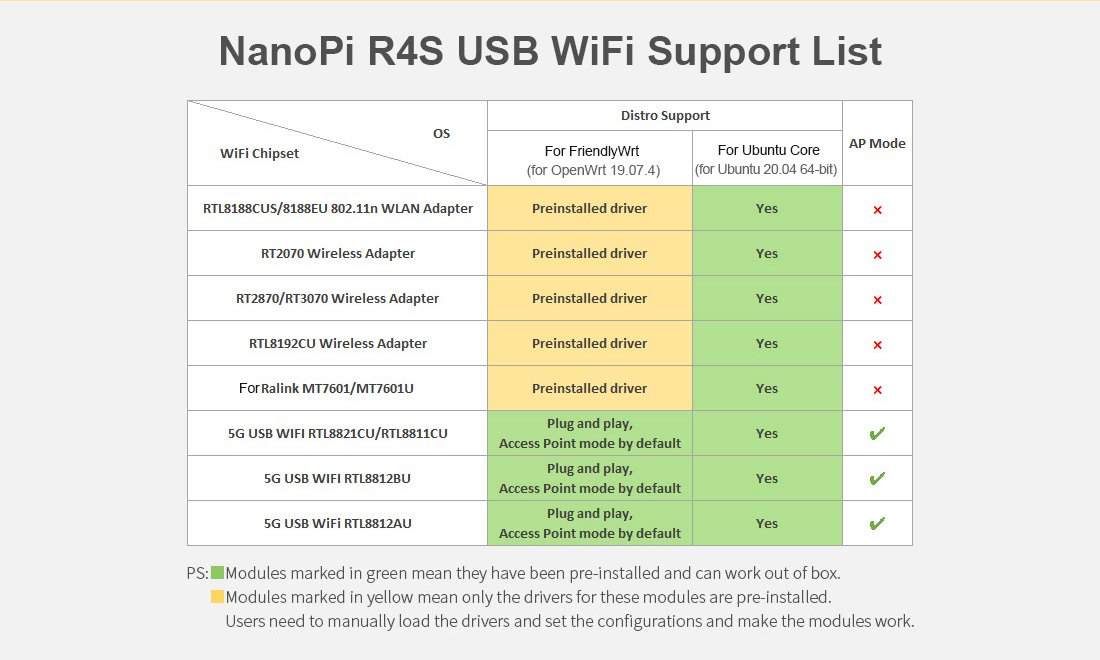
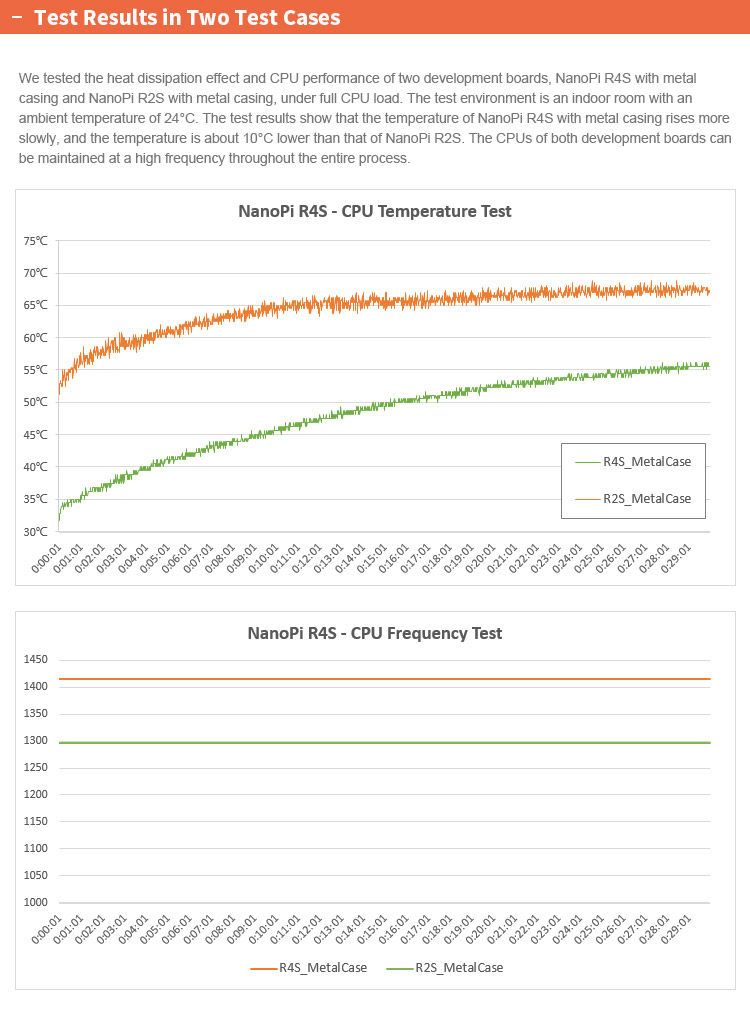
For detailed steps refer to: https://github.com/friendlyarm/cpu-temperature-test-script
Hardware Characteristics:
CPU:
- Model: For Rockchip RK3399
- Number of Cores: for 64-bit Dual Core Cortex-A72 + Quad Core Cortex-A53
- Frequency: for Cortex-A72 (up to 2.0GHz), Cortex-A53 (up to 1.5GHz)
GPU:
- Mali-T864 GPU , supports for OpenGL ES1.1/2.0/3.0/3.1, OpenVG1.1, OpenCL, DX11, and AFBC
VPU:
- 4K VP9 and 4K 10bits H265/H264 60fps decoding, Dual VOP, etc.
PMU:
- RK808-D PMIC, cooperated with independent DC/DC, enabling DVFS, software power-down, RTC wake-up, system sleep mode
Memory:
- RAM: 1GB DDR3/4GB LPDDR4
Storage:
- Flash: no Onboard eMMC
- MicroSD Slot: MicroSD x1 for external storage up to 128GB
Connectivity:
- Ethernet: Native Gigabit Ethernet x1
- PCIe Gigabit Ethernet x1
For MAC Address:
- Globally Unique Address for MAC
USB:
- USB 3.0 Host x2: USB Type A
- USB 2.0 Host x1: 2.54mm 4pin-header
- Type-C x1: Power Input Only
Pin-header:
- GPIO: 2.54mm pitch 2x5pin-header, include I2C x1, SPI x1
- Serial Debug Port x1: 2.54mm pitch 3pin-header, 3V level, 1500000bps
Button:
- User Button x1
LED:
- PWR LED(Red) x1
- STAT LED(Green) x1
- LAN LED(Green) x1
- WAN LED(Green) x1
Others:
- RTC: 2 Pin 1.27/1.25mm RTC battery input connector
- Fan: 5V Fan connector
- Working Temperature: -20℃ to 70℃
Power:
- DC 5V/3A, via USB-C connector or Pin header
System/Software Characteristics:
OS Support:
- For FriendlyCore 20.04 (64-bit) (for Linux-4.19.111 + U-boot-2017.09)
- For FriendlyWrt 19.07.5 (64-bit) (for Linux-5.10 + U-boot-2017.09)
Specifications:
- PCB: 8-Layer
- Dimension: 66x66 mm
- Product Weight: 310g (With Case)